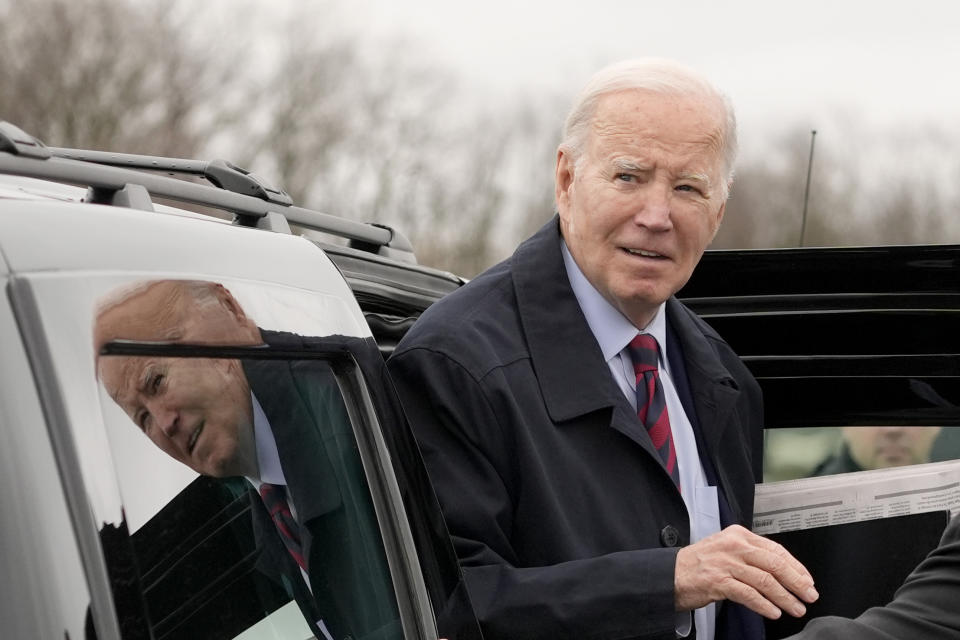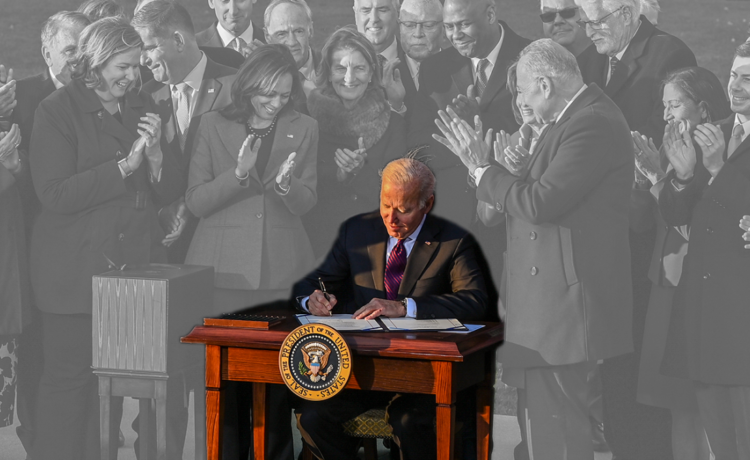Two signature laws of the Biden administration are spreading hundreds of billions across the country, funding everything from new roads in Florida to broadband lines in Alaska to green energy projects in California.
But where that $442 billion (so far) will have the most impact are places where voters are least likely to support Joe Biden in November, according to a new Yahoo Finance analysis of the latest White House data.
The largest recipients of funds approved by the Bipartisan Infrastructure Law and Inflation Reduction Act — when measured on a per capita basis — are four states that Biden himself lost by at least 10 points in 2020: Alaska, Montana, North Dakota, and Wyoming.
Of the 18 states where residents are set to benefit the most from the money on a per-capita basis, 12 were won by Donald Trump in 2020.


This geographic quirk highlights one of President Joe Biden’s most persistent election-year challenges: Americans who aren’t feeling — or are simply unimpressed — by his signature accomplishments after three years in office.
In just one remarkable recent example, a Bloomberg News/Morning Consult poll found that Donald Trump wins by a tally of 42% to 38% on the question of whom voters most trust to handle infrastructure.
That’s even after Biden signed a landmark infrastructure bill into law in 2021 and after four years in office that saw Trump take no significant action on the issue.
The White House is trying to re-introduce Americans to Biden’s key accomplishments as the 2024 presidential contest picks up pace, driving the message home with a recent State of the Union week messaging blitz, campaign stops and a new $30 million dollar ad campaign.
“Remember, the last president?” President Biden asked supporters at a recent stop. “He had ‘Infrastructure Week’ for four years and didn’t do a damn thing.”
Where the money is going
To map where the money went, Yahoo Finance examined White House data detailing disbursements from two signature Biden accomplishments: the Bipartisan Infrastructure Law and the Inflation Reduction Act.
Two other key Biden bills — the 2021 American Rescue Plan and the 2022 CHIPS and Science Act — were not included in the data.
The per capita impact of this spending was then calculated using population information from the US Census Bureau.
Of the projects that the White House data tied to a specific location, the transportation efforts are by far the most widespread. Those funds are being used for projects across the country, from western states as well as the “Acela corridor” along on the east coast.
This has made Transportation Secretary Pete Buttigieg the most prominent disburser of funds. The cameras cut to him when the subject came up during last week’s State of the Union address, and he’s traveling to all corners of the country to spread the message.
“I have never been in a press conference where there were whales breaching in the background,” he joked during a recent stop in Maui.
The money has also clearly caught the eye of “Amtrak Joe.” The president has long been known for a focus on transportation, most notably his love of trains and his daily commute via rail from Washington to Delaware when he was a Senator.
Each Delawarean will benefit from about $450 in transportation funding from these laws, according to Yahoo Finance’s analysis.
That’s in line with many areas of the country but is below some more rural states that — on a per capita basis — are in line for the most funds.
Alaskans, for example, are set to receive almost $2,500 each in transportation money as workers stretch to make the new roads for the state’s remote residents.
The trend is even more notable on other issues. When it comes to broadband, the money is once again largely going to rural states.
The broadband funds are also going to urban areas, such as a program to help poorer Americans pay their internet bills no matter where they live. But Biden officials have long noted how rural areas of the country are where connectivity is a big concern and the need is deepest.
“It’s so heartbreaking to spend time, as I’ve done, in rural America [where] there’s no broadband for miles, hundreds of miles,” Commerce Secretary Gina Raimondo, who oversees much of that effort, said in a 2022 interview.
Other slices of the money — notably the clean energy initiatives in the Inflation Reduction Act — are in fact being felt more in urban and coastal states.
But the overall per capita tallies still strongly favor places like Wyoming, which Biden lost by over 40 points in 2020.
A wave of private sector investments
The White House has also been closely tracking new private projects that have been announced since Biden took office.
The rate of those announcements grew steadily during Biden’s first two years, with hundreds of new projects launched around White House priorities like making semiconductors, EV batteries, and clean energy.
A different set of states are likely to feel the biggest impact here, due largely to the massive influx of investments in semiconductor projects. Arizona, Idaho, New York, Ohio, and Texas are the sites of new semiconductor manufacturing efforts with billions in new investments.
All told, according to White House data, the US has seen $235 billion in new semiconductor investments since Jan. 20, 2021. That money comes even as another Biden-era law — 2022’s CHIPs and Science Act — just begins to dole out money to further spur chipmaking in the US.
Thus far, three smaller government manufacturing awards have been rolled out to BAE Systems (BAESY), Microchip Technology, and GlobalFoundries (GFS).
But the biggest grants are likely to head to chipmaking giants in the weeks ahead. Intel (INTC) may be in line for more than $10 billion while Taiwan Semiconductor Manufacturing Company (TSMC) could get more than $5 billion, according to recent Bloomberg reports.
Watch for Biden to keep highlighting these numbers while also pointing out what he calls GOP hypocrisy for touting the money as it lands in their states.
Biden brought it up during last week’s State of the Union address, jokingly telling Republican lawmakers “if any of you don’t want that money in your districts, let me know.”
Ben Werschkul is Washington correspondent for Yahoo Finance. David Foster is a graphic artist for Yahoo Finance.
Click here for politics news related to business and money
Read the latest financial and business news from Yahoo Finance















